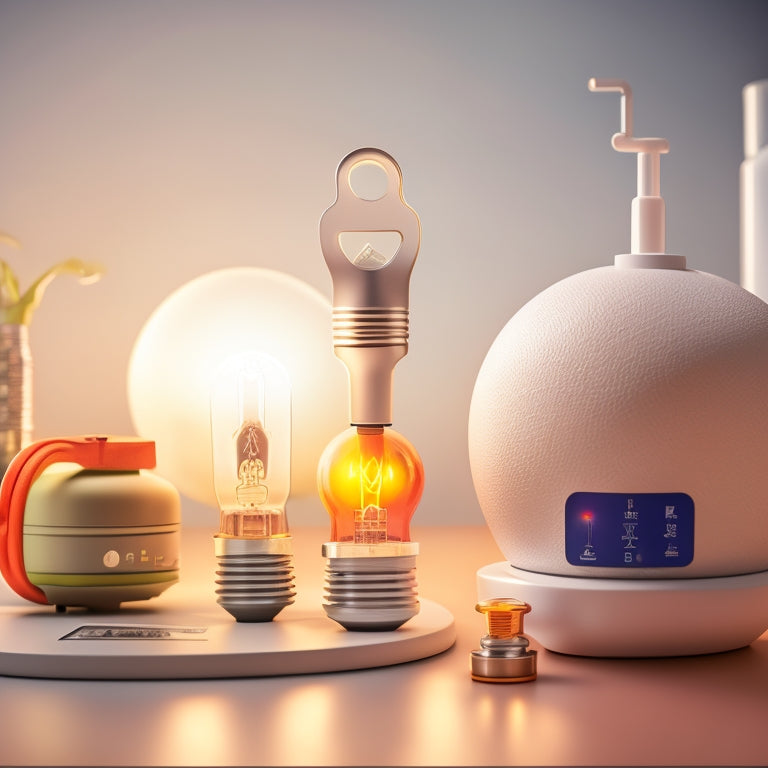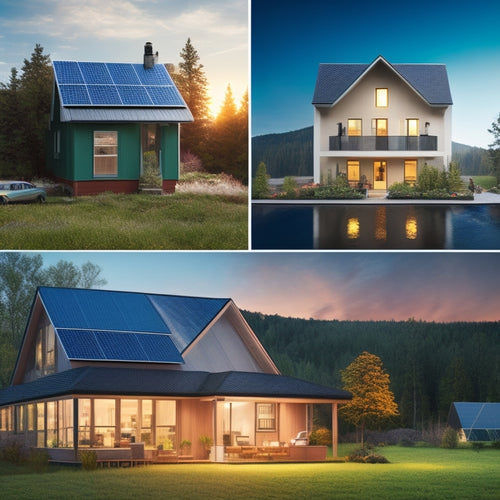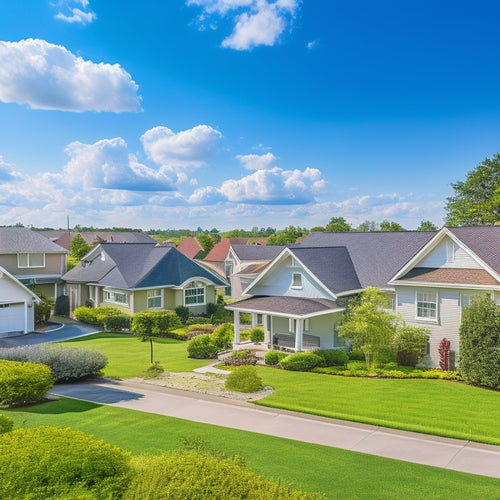
What Are Load-Balancing Plugs for Energy Conservation?
Share
You're likely familiar with the concept of load balancing in high-traffic networks, but did you know it can also optimize energy distribution and reduce waste in your home or business? Load-balancing plugs employ advanced energy monitoring technology to track consumption in real-time, enabling smart plug functionality for remote control and scheduling. They reduce standby power consumption through automated power control, promoting integration with renewable energy sources. By balancing energy distribution, these plugs minimize waste, lower your carbon footprint, and lead to significant energy savings. Now, uncover how they can be integrated into your smart home setup and investigate their full potential.
Key Takeaways
- Load-balancing plugs distribute power efficiently to multiple devices, reducing energy waste and promoting sustainability.
- These plugs utilize advanced energy monitoring technology for real-time tracking and automated power control.
- They enable smart plug functionality for remote control and scheduling, leading to significant energy savings and a reduced carbon footprint.
- Load-balancing plugs optimize energy distribution, reducing standby power consumption and addressing "vampire power" issues.
- By providing real-time energy usage data, these plugs empower users to make data-driven decisions for a more energy-efficient future.
Understanding Load Balancing Technology
You're likely familiar with the concept of load balancing, but what exactly is it, and how does it work?
Fundamentally, load balancing is a technique used to distribute workloads across multiple devices or resources to optimize performance, reliability, and energy efficiency. By spreading the load, you can guarantee that no single device becomes overwhelmed, leading to improved responsiveness and reduced downtime.
This approach is particularly vital in high-traffic networks, data centers, and cloud computing environments. For instance, DC Fast Charging Stations can benefit from load balancing to efficiently manage the high power demands of electric vehicle charging.
How Energy Conservation Plugs Work
You'll find that energy conservation plugs rely on advanced energy monitoring technology to track your appliance's power consumption in real-time, similar to how smart charging systems reduce energy waste and carbon emissions by optimizing grid usage during off-peak hours.
This data is then used to enable smart plug functionality, allowing you to control and schedule power distribution remotely, which can be especially useful when paired with renewable energy sources like solar and wind power.
Through automated power control, these plugs can optimize energy usage and reduce standby power consumption, ultimately leading to significant energy savings.
Energy Monitoring Technology
With the rise of smart homes and energy-efficient living, energy conservation plugs have become increasingly popular. You're probably wondering how they work their magic. It's all about energy monitoring technology.
This technology enables you to track your energy consumption in real-time, providing you with useful revelations into your power management habits. By gaining a better understanding of your energy usage, you can make behavioral changes that reduce your environmental impact, such as reducing carbon footprint and promoting sustainable practices.
Additionally, it's crucial to incorporate eco-friendly habits into daily routines, like energy reduction and waste management, which have a substantial impact. The technology is device-compatible, ensuring seamless integration with your existing appliances.
Furthermore, it promotes grid stability and provides efficiency metrics, resulting in cost savings. By leveraging this technology, you can take control of your energy usage, making conscious choices that contribute to a more sustainable future.
Smart Plug Functionality
The heart of energy conservation plugs lies in their smart plug functionality. This feature allows you to monitor and control your appliances' energy usage remotely. You can integrate these plugs with your smart home system, enabling seamless smart plug integration. This integration enables you to set schedules, receive notifications, and monitor energy usage in real-time.
| Feature | Description |
|---|---|
| Real-time Monitoring | Track energy usage of individual appliances |
| Remote Control | Turn appliances on/off from your smartphone |
| Scheduling | Set schedules for appliances to turn on/off automatically |
With smart plug functionality, you can make data-driven decisions to reduce your energy consumption and lower your utility bills. By optimizing your energy usage, you're not only saving money but also contributing to a more sustainable future.
Automated Power Control
By virtue of their automated power control, energy conservation plugs seamlessly regulate the flow of power to your appliances, ensuring that energy is used efficiently and effectively.
This advanced technology enables you to optimize energy consumption by setting automated scheduling for your devices, allowing you to turn them on and off when not in use.
In addition, these plugs make agile adjustments to power output based on the device's specific requirements, eliminating standby power consumption.
Moreover, by leveraging Energy Storage Systems, energy conservation plugs can also reduce peak demand on the grid, enhancing energy efficiency.
This precise control over energy distribution enables you to take charge of your energy usage, giving you the freedom to make informed decisions about your consumption habits and reduce your environmental footprint.
Load Balancing in Smart Homes
Frequently, homeowners in smart homes face the challenge of managing their energy consumption efficiently, and load balancing plays an essential role in achieving this goal. By optimizing energy distribution, you can reduce your energy demand and save on your utility bills.
| Smart Home Integration | Energy Demand |
|---|---|
| Automation of lights and appliances | Peak energy usage during the day |
| Real-time energy monitoring | Energy-intensive devices prioritized |
| Customizable energy schedules | Energy consumption balanced across devices |
With load balancing, you can guarantee that your smart home integration prioritizes energy efficiency, making the most of your energy resources. By understanding your energy demand patterns, you can adjust your energy consumption to achieve a more balanced and sustainable lifestyle.
Benefits of Energy Saving Plugs
You've optimized your smart home's energy distribution through load balancing. Now it's time to take energy conservation to the next level with energy-saving plugs.
These innovative devices can seamlessly integrate with your smart home system, providing real-time monitoring and control over energy usage. By plugging your appliances into energy-saving plugs, you can reduce standby power consumption, also known as vampire power, which can account for up to 10% of your energy bill.
Additionally, incorporating fast charging infrastructure and solar-powered charging solutions can further minimize your carbon footprint. This results in significant energy cost reduction, putting more money back in your pocket.
With smart home integration, you can remotely monitor and control energy usage, enjoying the freedom to make data-driven decisions about your energy consumption.
Reducing Energy Waste With Plugs
In the domain of energy conservation, eliminating unnecessary power drain is essential, and energy-saving plugs play an important role in this effort. You can considerably reduce energy waste by using plugs designed with energy conservation in mind. These plugs are engineered to detect and cut power to devices in standby mode, eliminating standby power consumption.
| Feature | Benefit |
|---|---|
| Auto-shutoff | Eliminates standby power consumption |
| Smart sensing | Detects device standby mode |
| Energy monitoring | Provides real-time energy usage data |
Load Balancing for Sustainable Living
As you investigate ways to reduce energy waste, you'll find that optimizing your home's power distribution is essential to sustainable living.
By implementing load balancing, you can guarantee that your energy efficient appliances operate at their maximum potential. This approach allows you to distribute power evenly, reducing strain on your electrical system and minimizing energy loss.
By adopting sustainable practices, such as load balancing, you'll not only reduce your carbon footprint but also enjoy significant cost savings.
By taking control of your energy consumption, you're taking an important step towards a more sustainable future.
Plugs for Energy Efficiency Gains
They're often overlooked, but the humble plug can play a crucial role in your energy efficiency gains.
By using load-balancing plugs, you can optimize your energy consumption and develop energy saving habits. These plugs work by distributing power to your appliances efficiently, ensuring that each device receives the right amount of energy. This results in reduced energy waste and lower utility bills.
When paired with efficient appliances, load-balancing plugs can greatly reduce your carbon footprint. By taking control of your energy consumption, you're not only saving money, but also contributing to a more sustainable future.
Load Balancing in Real-Time Scenarios
The flexible nature of modern appliances demands real-time load balancing to enhance energy efficiency. You need a system that can respond quickly to changes in energy demand.
Adaptive load balancing enables real-time adjustments to guarantee that your appliances are operating within ideal energy ranges. This means that when you're not using a device, the load balancing plug can detect the change and adjust the energy supply accordingly.
Energy Monitoring With Load Balancing
Monitoring your energy consumption in real-time becomes seamless with load balancing plugs, allowing you to pinpoint areas of inefficiency and optimize your energy usage.
You can track your energy usage patterns, identifying peak demand periods and making adjustments to reduce consumption during those times. Load distribution is optimized, ensuring that power is allocated efficiently across your devices.
Smart metering and electrical monitoring provide granular observations into your energy usage, enabling you to make data-driven decisions. By leveraging load balancing plugs, you can respond to demand response signals, shifting non-essential loads to off-peak hours and reducing strain on the grid.
This level of control and visibility enables you to allocate resources more efficiently, reducing waste and saving energy.
Future of Energy Conservation Plugs
Your energy conservation efforts are about to get a significant enhancement as load-balancing plug technology continues to evolve.
Future innovations will bring even more sophisticated features to these eco-friendly designs.
Here are three exciting developments to look forward to:
-
Advanced AI Integration: Load-balancing plugs will learn your energy usage patterns and optimize energy distribution for maximum efficiency.
-
Enhanced Real-time Monitoring: Get instant updates on your energy consumption and receive personalized recommendations for reducing waste.
-
Seamless Integration with Renewable Energy Sources: Load-balancing plugs will be designed to work in harmony with solar panels, wind turbines, and other renewable energy sources, ensuring maximum energy independence.
Frequently Asked Questions
Can Energy-Saving Plugs Be Used With Appliances That Have Motors?
You can use energy-saving plugs with motor-based appliances, but you'll want to check their compatibility first, as some motors may not operate efficiently or could even be damaged, affecting overall motor efficiency and appliance performance.
Are Load-Balancing Plugs Compatible With Older Electrical Systems?
When you're considering load-balancing plugs, you'll want to verify they're compatible with your older electrical system, addressing compatibility concerns and adhering to current electrical standards to confirm safe and efficient energy distribution.
Do Energy Conservation Plugs Affect Appliance Performance or Lifespan?
You won't compromise appliance performance or lifespan with energy conservation plugs, which optimize appliance efficiency, ensuring you reap energy savings without sacrificing functionality, giving you the freedom to reduce your carbon footprint without worrying about device reliability.
Can I Use Energy-Saving Plugs With Medical Equipment or Lifesaving Devices?
You shouldn't assume energy-saving plugs are universally compatible; instead, you must prioritize medical equipment compatibility and lifesaving device safety, ensuring the plug won't disrupt critical functions or compromise performance, especially in life-critical situations.
Are Load-Balancing Plugs Suitable for Outdoor or Industrial Applications?
When considering outdoor usage or industrial applications, you'll want to guarantee load-balancing plugs meet IP67 or NEMA ratings for water and dust resistance, and can withstand extreme temperatures, vibration, and power surges.
Related Posts
-

What Does Your Home Energy Audit Report Reveal?
Your home energy audit report reveals a detailed analysis of your energy consumption patterns, highlighting areas of ...
-

What Cool Roof Tax Breaks Can Homeowners Claim?
You can claim federal tax credits of up to $500 and state and local incentives for installing cool roofs, which not o...
-

7 Smart Air Purification Hacks for Energy-Savvy Homes
You can notably improve your indoor air quality while minimizing energy consumption by implementing strategic air pur...


